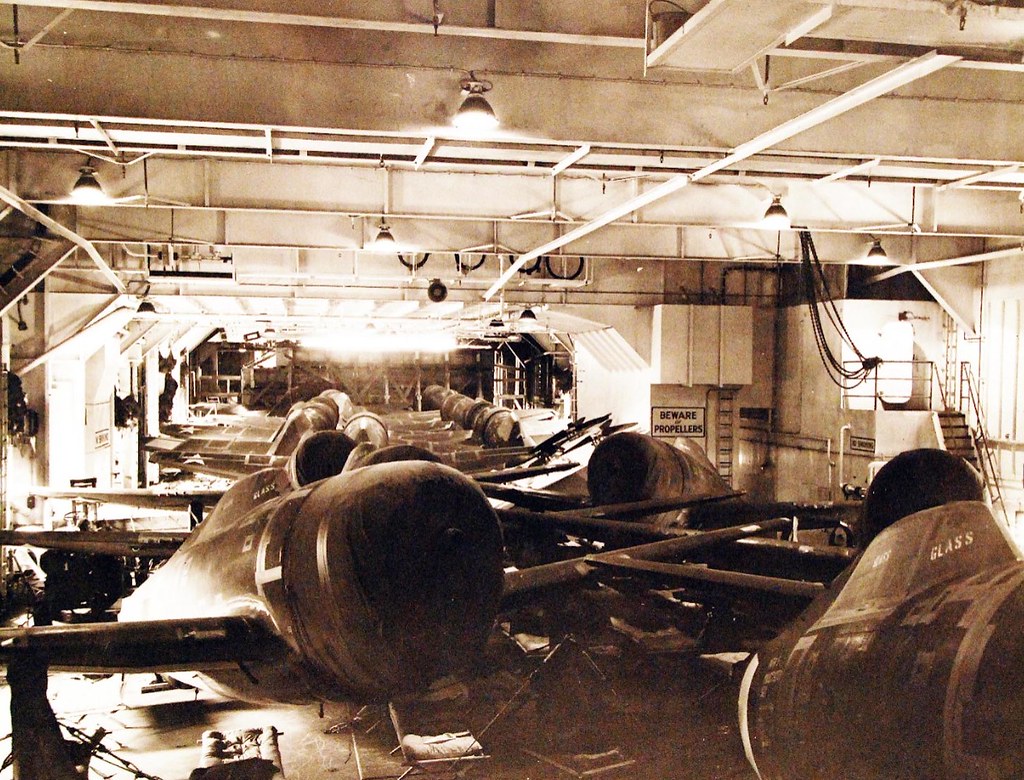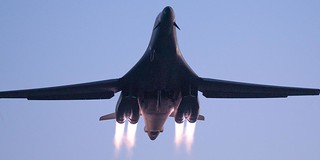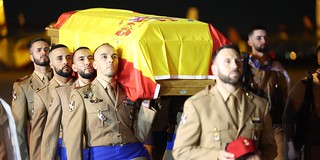USS Block Island: the story of the carrier that was sunk west of the Canary Islands
Over the past century, 51 aircraft carriers have sunk to the bottom of the sea. One of them did so in the waters of the Atlantic Ocean, west of the Canary Islands.
An oil tanker converted to an escort aircraft carrier
USS Block Island (CVE-21) was an escort carrier of the United States Navy, the eighth of 11 Bogue-class built between 1941 and 1943. She was 151 meters long and nearly 34 meters beam, and a displacement of 15,200 tons. It was laid down on January 19, 1942, being built in Tacoma, Washington (on the west coast of the United States), by the Seattle-Tacoma Shipbuilding Corporation shipyard .

She was launched in record time: on May 1, 1942, although it took more than a year to enlist in the US Navy, entering service on March 8, 1943. The speed of her construction is explained by the fact that she was originally a C3-S-A1 class tanker, the 237 (as was the case with five other tankers of this type). These improvised aircraft carriers were popularly known as "Jeep Carriers" or "Baby Flattops", and the US put special effort into building them since it took much less time to get them ready than to build larger aircraft carriers and it was easier replace them.

Powered by a steam turbine, the USS Block Island could reach a speed of 17.6 knots (32 km/h). Her crew of hers consisted of 890 men. Most of them had no experience. The exception was 50 former sailors from the aircraft carrier USS Lexington (CV-2) , sunk by the Japanese in the Battle of the Coral Sea. USS Block Island's armament consisted of two 5-inch guns, 20 40-mm anti-aircraft guns, and 27 20-mm guns. She could carry up to 28 planes . For access to the hangar, she had two elevators, both located in the middle of the flight deck: one aft and one forward.

Her first trips and her first combat missions
After her enlistment, she was placed under the command of Captain Logan C. Ramsey and sent to San Diego, from where he sailed for the naval base in Norfolk, Virginia, in May 1943, < strong>joining the Atlantic fleet. Her first mission began in July 1943 with a journey carrying P-47 Thunderbolt fighters from Staten Island, New York, to Belfast, Northern Ireland. After a second crossing of the Atlantic, also to transport P-47s, on October 15, 1943 USS Block Island began herts first combat mission to search for German submarines in the Atlantic, heading north of the Azores Islands.

Returning to Norfolk in November 1943, USS Block Island received a new air wing, Composite Squadron 58 (VC-58) , consisting of 9 Grumman F4F Wildcat fighters and 12 Grumman TBF Avenger naval bombers. In addition, the ship was equipped with a new anti-submarine weapon, consisting of a rocket with a steel head. The US Navy intended to test it for the first time on this ship. The carrier sailed on her second combat cruise on December 15, 1943, again to hunt submarines north of the Azores. Following a fateful Christmas Day, when one of her destroyers of escort, the ship arrived in Casablanca to restock.

The USS Block Island's bad luck in her war against German submarines seemed to change on January 11, 1944, when two of her Avenger bombers attacked submarine U-758, damaging it and forcing it to return to her based in Saint-Nazaire, France. Three days later, the ship rescued 43 survivors from U-231, sunk shortly before by the British. On February 3, 1943, the USS Block Island was back in Norfolk. After yet another combat mission, USS Block Island began her fourth and final combat mission on April 29, 1944, under the command of Captain Francis Massie Hughes, in order to relieve another Bogue-class aircraft carrier, USS Croatan (CVE-25) west of Cape Verde. After a hard encounter of her combat group with the German submarine U-66, USS Block Island arrived at Casablanca to resupply on May 18, 1944.

The sinking of the USS Block Island by the submarine U-549
Five days later, the ship put out to sea again, heading west of Cape Verde. On May 28, one of her Avengers detected by radar the German submarine U-549, type IXc and which was doing her first patrol mission. In the early morning of May 28-29, contact with the submarine was lost. The rest of the day the ship continued to search for her enemy. At dusk, the periscope of U-549 surfaced just ahead of the USS Block Island. At 20:13, the submarine fired a torpedo that struck the bow of the carrier. A second torpedo struck the stern, penetrating an ammunition dump. At 20:23 U-549 fired a third torpedo which also hit the carrier.

After the third impact, the ship was doomed. Captain Hughes gave the order to abandon ship. U-549 fired a fourth torpedo at the carrier at 20:30, hitting one of her escort ships, the destroyer USS Barr (DE-546), damaging her and killing four of her crew. Two other destroyer escorts, USS Eugene E. Elmore (DE-686) and USS Ahrens (DE-575), led an attack against U-549, managing to catch up with her. The submarine was destroyed with a huge explosion, sinking to the bottom of the sea with her 57 crew members on board.

The crew of the USS Block Island left the ship on the starboard side, in order to take advantage of the wind to get away from the ship. At 9:00 pm almost the entire crew was in the rafts. Captain Hughes remained on board with some men who were trying to free another crew member whose leg had become trapped. Unfortunately, attempts to free him were unsuccessful and a surgeon had to amputate his leg. The sailor passed away shortly after.
At 21:40 the ship had been completely evacuated. Only the bodies of six crew members who died as a result of the German attack remained on board. At 21:55, the aircraft carrier sank and immediately after her ammunition depots exploded, causing an explosion that shook such to the destroyer USS Ahrens which her crew believed to be a new German attack. The USS Block Island was the only US aircraft carrier sunk in the Atlantic during World War II.

Two airmen from the USS Block Island arrived in the Canaries
The crew of the USS Block Island were picked up by two destroyer escorts: the USS Ahrens and the USS Robert I. Paine (DE-578), being taken to Casablanca, from where they were repatriated on three aircraft carriers of shooting guard. Six Wildcat fighters from the USS Block Island were in the air when the carrier was sunk about 300 nautical miles west-northwest of the Canary Islands. With nowhere to land, the six planes headed for the Azores and towards Casablanca, in a desperate attempt to reach land.

Two of the pilots reached the Azores, and two others -Lieutenant James G. McDaniel and Lieutenant John F. Carr- had to ditch in the waters of the Canadian Islands. Carr ditched on the coast of Cueva Bonita, in Tijarafe (island of La Palma), thinking that it was on the Portuguese island of Madeira. He was rescued on May 31 by a Spanish fishing boat on May 31, and after arriving in the Canaries, was sent to Gibraltar shortly thereafter. The minelayer gunship "Tritón" F-22 of the Spanish Navy went out to sea in search of the other American aviators, without finding any of the castaways.
Bibliography:
- "CVE 21 USS Block Island", by Jack Greer and Jack Sprague, in USSBlockIsland.us.
- "USS Block Island (CVE 21)", in Uboat.net.
- "Un caza norteamericano ameriza en Tijarafe durante la Segunda Guerra Mundial", in La Palma y el Mar.
- "John F. Carr el piloto americano apresado en La Palma", by Fernando Rodríguez Sánchez in Mundolapalma.
---
Main photo: U.S. Navy / Naval Historic and Heritage Command. USS Block Island during her sea trials in March 1943.
|
Don't miss the news and content that interest you. Receive the free daily newsletter in your email: |
- Most read
- The brutal 'touch and go' of a Lufthansa Boeing 747 at Los Angeles Airport
- The massive takeoff of more than half of the United States B-2 Spirit stealth bombers
- Honors to Corporal Palacios of the Spanish Army who died in an exercise in Poland
- Portugal confirms that it has begun its transition to the F-35 and indicates bad news for Spain
- Eurofighter vs F-35: the opinions of professional pilots on these advanced fighters
- This is the driver station of an M1 Abrams tank and the impressive start of its engine
- The deployment of Spanish soldiers of the Regulars and BRILAT near Russian territory

 ES
ES







Opina sobre esta entrada: